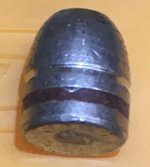Spent a while in the reloading room today (when I should have been doing other things) trying to figure out my Ruger SR45 problem. I had been shooting some plated 200 gr. TC the last time out, and previously Berry's RNFP which I think I'm now out of. None has been 100% reliable. But I do have some hard cast RNFP that I think were cast in Magma molds, so decided to load up a few of them to see if they will work.
They are ..452 and I can only just taper crimp them to .470/1. (Lee Cast progressive & dies + FCD.)
They clear the barrel hood and will
just plunk. When I ran one in from the mag, though, there was some damage to the bullet nose, so something's not right. The gun does go completely into battery, however, which seemed to be the problem last week with the TC rounds.
It could be that the chamber is a bit tight. They drop in and out perfecty in my STI Spartan 1911, which eats anything I feed it. I'm going to load some up and take them to the range with the SR45 and see what transpires.




